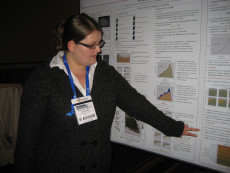Kate Odziomek Receives ACS Scholarship for Scientific Excellence
August 22, 2014
Contact: Linda Vu, +1 510 495 2402, lvu@lbl.gov

Kate Odziomek presenting her poster at the 2014 American Chemical Society National Meeting & Exposition held Aug. 10-14 in San Francisco. (Photo by Wendy Warr, ACS Member)
Katarzyna (Kate) Odziomek, a visiting graduate student in chemistry from the University of Gdansk, Poland won the Chemical Information section (CINF) Scholarship for Scientific Excellence at the 2014 American Chemical Society National Meeting & Exposition held Aug. 10-14 in San Francisco. She won for her poster presentation “Toward Quantitative Structure Activity Relationship (QSAR) Models for Nanoparticles,” which described a quantitative algorithmic framework for extracting information about nanoparticles from scanning electron microscope (SEM) images.
“When people look at SEM images, they usually look only at nanoparticle size distribution. But, a lot more information can be extracted from these images—like particle shape and surface texture,” says Odziomek. “These features are really important because the way some nanoparticles intereact is heavily reliant on their morphology or surface structure.”
Over the past year, Odziomek developed the framework while working with scientists from the Center for Applied Mathematics for Energy Research Applications (CAMERA): Visualization Group’s Daniela Ushizima and Scientific Computing Group’s Maciej Haranczyk. Her stay in the Berkeley Lab was made possible thanks to the European Union-funded NanoBRIDGES project, which is aimed at creating a worldwide network of research partnerships that is focused on the development of new tools for computational risk assessment of engineered nanoparticles.
“When I decided to come to Berkeley Lab, I hoped to spark collaborations with top scientists who would offer new perspectives about how to approach my research. And, that’s exactly what happened,” says Odziomek. “ My advisor introduced me to Maciej, who is a computational chemist by training, like me, but his current emphasis is on materials informatics. After we discussed what I would like to achieve by the end of my stay, Maciej introduced me to Daniela, who is an expert in image analysis, and she worked with me to build the framework.”
As she heads back to Poland this week, Odziomek hopes to continue the work she started at Berkeley Lab. “The next step for me is to use the features that we extracted from the SEM images and incorporate them into models,” she says. “Nanoparticles are tricky, they don’t act like bulk molecules (chemicals) and they don’t act like single molecules—they are something in between, so conventional modeling tools don’t always work. We need new tools, that’s why our models are important.”
In addition to Haranczyk and Ushizima, Odziomek’s advisor at the University of Gdansk, Tomasz Puzyn, was also a co-author on the poster. Puzyn previously worked with Haranczyk at Berkeley Lab under the NanoBridges program. The team is currently working on a paper, which will be submitted for publication later this year.
About Berkeley Lab
Founded in 1931 on the belief that the biggest scientific challenges are best addressed by teams, Lawrence Berkeley National Laboratory and its scientists have been recognized with 16 Nobel Prizes. Today, Berkeley Lab researchers develop sustainable energy and environmental solutions, create useful new materials, advance the frontiers of computing, and probe the mysteries of life, matter, and the universe. Scientists from around the world rely on the Lab’s facilities for their own discovery science. Berkeley Lab is a multiprogram national laboratory, managed by the University of California for the U.S. Department of Energy’s Office of Science.
DOE’s Office of Science is the single largest supporter of basic research in the physical sciences in the United States, and is working to address some of the most pressing challenges of our time. For more information, please visit energy.gov/science.









